Native
Cydia youngana (Kearfott) (Tortricidae: Olethreutinae: Grapholitini)
Common name: spruce seed moth, spruce cone moth
Note: The North American population previously known as C. strobilella was recently demonstrated to be distinct from the Eurasian population based on pheremone and genetic data (Svensson et al. 2012Svensson et al. 2012:
Svensson, G., Wang, H.-L., Lassance, J.-M., Anderbrant, O., Chen, G.-F., Gregorsson, B., Guertin, C., Harala, E., Jirle, E., Libkas, I., Petko, V., Roques, A., Rosenberg, O., Strong, W., Voolma, K., Ylioja, T., Wang, Y.-J., Zhou, X.-M., Louml;fstedt, C. 2012. Assessment of genetic and pheromonal diversity of the Cydia strobilella species complex (Lepidoptera: Tortricidae). Systematic Entomology. 38(2): 305-315.). The name which applies to the North American taxon is Cydia youngana (Kearfott).
FWLFWL:
forewing length; the distance from the base of the forewing to the apex, including fringe : 4.5-7.0 mm
: 4.5-7.0 mm
Adults are dark brown with lighter, metallic, transverse markings. Hindwings are brown. Males lack a forewing costal foldforewing costal fold:
a flap or fold at the base of the forewing that contains specialized sex scales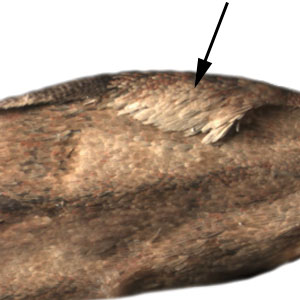 .
.
Male genitalia are characterized by the absence of an uncusuncus:
a sclerotized process which is fused to the posterodorsal margin of tergum IX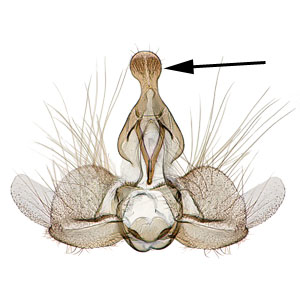 and terminally rounded valvaevalva:
and terminally rounded valvaevalva:
an appendage flanking the intromittent organ that is used to clasp the female during copulation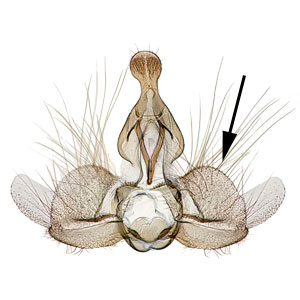 with a moderate constriction at the ventralventral:
with a moderate constriction at the ventralventral:
lower, to the bottom, on the under side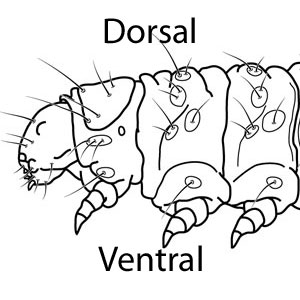 base of the cuculluscucullus:
base of the cuculluscucullus:
the distal portion of the male valva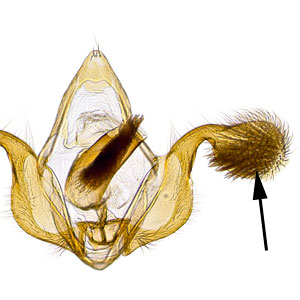 and a large basal cavity. Female genitalia are characterized by a well-sclerotized ductus bursaeductus bursae:
and a large basal cavity. Female genitalia are characterized by a well-sclerotized ductus bursaeductus bursae:
a membranous tube connecting the ostium bursae to the corpus bursae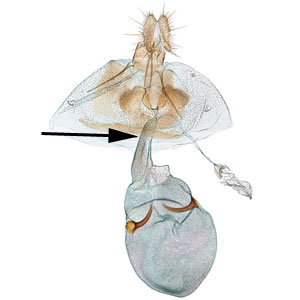 and two small tack-like signasignum:
and two small tack-like signasignum:
a sclerotized projection or patch on the interior of the corpus bursae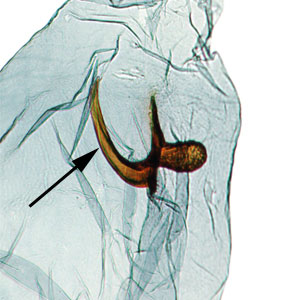 in the corpus bursaecorpus bursae:
in the corpus bursaecorpus bursae:
a dilated membranous sac at the anterior end of the bursa copulatrix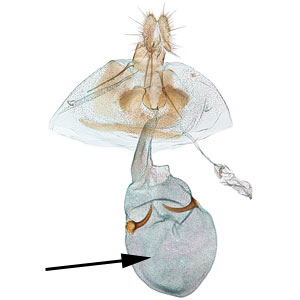 .
.
The following account is summarized from Tripp (1954)Tripp (1954):
Tripp, H. A. 1954. Description and habits of the spruce seed-worm ( Laspeyresia youngana (Kft.) (Lepidoptera: Olethreutidae)). Canadian Entomologist. 86: 385-402. and MacKay (1959)MacKay (1959):
MacKay, M. R. 1959. Larvae of the North American Olethreutidae (Lepidoptera). Canadian Entomologist, Supplement 10: 1-338..
Mature larva approximately 7-10 mm in length; width of head 0.6-0.8 mm; head yellow-brown with darker laterallateral:
to the side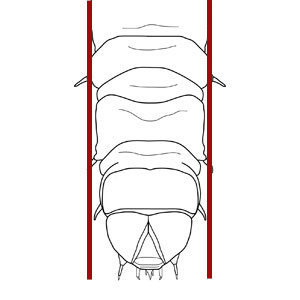 pigmentation; prothoracic shieldprothoracic shield:
pigmentation; prothoracic shieldprothoracic shield:
a sclerotized plate on the dorsal surface of the prothorax 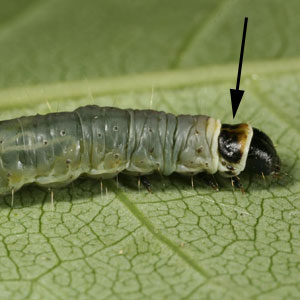 , body, legs, and anal shieldanal shield:
, body, legs, and anal shieldanal shield:
a sclerotized plate on the dorsal surface of the last abdominal segment (in larvae) 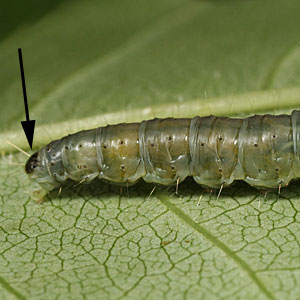 pale yellow to white; anal fork absent; SV group on A1, 2, 7, 8, 9 usually 2:2:1:1:1.
pale yellow to white; anal fork absent; SV group on A1, 2, 7, 8, 9 usually 2:2:1:1:1.
Detailed figures of larval chaetotaxychaetotaxy:
the arrangement of setae (in reference to Lepidoptera larvae), often depicted on a "setal map"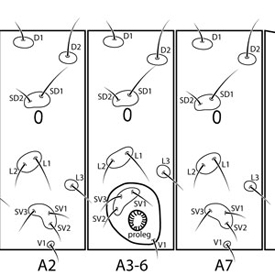 are available in Tripp (1954)Tripp (1954):
are available in Tripp (1954)Tripp (1954):
Tripp, H. A. 1954. Description and habits of the spruce seed-worm ( Laspeyresia youngana (Kft.) (Lepidoptera: Olethreutidae)). Canadian Entomologist. 86: 385-402. and MacKay (1959)MacKay (1959):
MacKay, M. R. 1959. Larvae of the North American Olethreutidae (Lepidoptera). Canadian Entomologist, Supplement 10: 1-338..
Pupa light amber, changing to dark brown or black immediately before eclosion of the adult. Male pupae 3.7 mm in length on average; females 4.5 mm in length on average.
Cydia youngana is similar to C. strobilella from Europe and Asia. For a while, the two species were considered synonymous (Brown & Miller 1983). They are now considered separate species based on differences in pheremone composition and DNA sequence data (Svensson et al. 2012Svensson et al. 2012:
Svensson, G., Wang, H.-L., Lassance, J.-M., Anderbrant, O., Chen, G.-F., Gregorsson, B., Guertin, C., Harala, E., Jirle, E., Libkas, I., Petko, V., Roques, A., Rosenberg, O., Strong, W., Voolma, K., Ylioja, T., Wang, Y.-J., Zhou, X.-M., Louml;fstedt, C. 2012. Assessment of genetic and pheromonal diversity of the Cydia strobilella species complex (Lepidoptera: Tortricidae). Systematic Entomology. 38(2): 305-315.). They are best separated by distribution; genitalia and life histories are virtually identical.
The following account is summarized from Tripp (1954)Tripp (1954):
Tripp, H. A. 1954. Description and habits of the spruce seed-worm ( Laspeyresia youngana (Kft.) (Lepidoptera: Olethreutidae)). Canadian Entomologist. 86: 385-402..
Heinrich (1926) stated that two generations occur per year in North America, but Tripp (1954)Tripp (1954):
Tripp, H. A. 1954. Description and habits of the spruce seed-worm ( Laspeyresia youngana (Kft.) (Lepidoptera: Olethreutidae)). Canadian Entomologist. 86: 385-402. found evidence for only a single generation per year in Ontario. Some larvae may require more than one year to complete development.
Adults eclose in late April to early June depending on latitude. Females lay eggs singly under the scales of young cones. Early instar larvae feed on the scales, later moving to the seeds. Mid- to late instars tunnel inside the cone and form a double, branched mine. Mature larvae overwinter and pupate the following spring in the cone. Each cone may support several larvae.
Larvae are a pest of spruce and have been recorded feeding on various other Pinaceae.
| Host plant | Host plant family | Reference(s) |
| Abies alba | Pinaceae | Heinrich 1926Heinrich 1926: Heinrich, C. 1926. Revision of the North American moths of the subfamilies Laspeyresiinae and Olethreutinae. Bulletin of the United States National Museum. 132: 1-216. |
| Picea abies | Pinaceae | Prentice 1966Prentice 1966: Prentice, R. M. 1966. Vol. 4. Microlepidoptera. In : Forest Lepidoptera of Canada recorded by the Forest Insect Survey. Dept. For. Canada Publ. 1142: 543-840. |
| Picea engelmanni | Pinaceae | Prentice 1966Prentice 1966: Prentice, R. M. 1966. Vol. 4. Microlepidoptera. In : Forest Lepidoptera of Canada recorded by the Forest Insect Survey. Dept. For. Canada Publ. 1142: 543-840.; Schmid et al. 1981Schmid et al. 1981: Schmid, J. M., Mitchell, J. C., Stevens, R. E. 1981. Cydia youngana (Kearfott) (Lepidoptera: Tortricidae) and associates in Engelmann spruce cones., Fraser Experimental Forest, Colorado. U.S. Dept. Agric. For. Serv. Res. Note RM No. 394: 1-5. |
| Picea glauca | Pinaceae | Prentice 1966Prentice 1966: Prentice, R. M. 1966. Vol. 4. Microlepidoptera. In : Forest Lepidoptera of Canada recorded by the Forest Insect Survey. Dept. For. Canada Publ. 1142: 543-840. |
| Picea mariana | Pinaceae | Prentice 1966Prentice 1966: Prentice, R. M. 1966. Vol. 4. Microlepidoptera. In : Forest Lepidoptera of Canada recorded by the Forest Insect Survey. Dept. For. Canada Publ. 1142: 543-840. |
| Picea pungens | Pinaceae | Prentice 1966Prentice 1966: Prentice, R. M. 1966. Vol. 4. Microlepidoptera. In : Forest Lepidoptera of Canada recorded by the Forest Insect Survey. Dept. For. Canada Publ. 1142: 543-840. |
| Picea rubens | Pinaceae | Prentice 1966Prentice 1966: Prentice, R. M. 1966. Vol. 4. Microlepidoptera. In : Forest Lepidoptera of Canada recorded by the Forest Insect Survey. Dept. For. Canada Publ. 1142: 543-840. |
| Picea sitchensis | Pinaceae | Heinrich 1926Heinrich 1926: Heinrich, C. 1926. Revision of the North American moths of the subfamilies Laspeyresiinae and Olethreutinae. Bulletin of the United States National Museum. 132: 1-216.; Prentice 1966Prentice 1966: Prentice, R. M. 1966. Vol. 4. Microlepidoptera. In : Forest Lepidoptera of Canada recorded by the Forest Insect Survey. Dept. For. Canada Publ. 1142: 543-840. |
| Picea sp. | Pinaceae | Tripp 1954Tripp 1954: Tripp, H. A. 1954. Description and habits of the spruce seed-worm ( Laspeyresia youngana (Kft.) (Lepidoptera: Olethreutidae)). Canadian Entomologist. 86: 385-402.; MacKay 1959MacKay 1959: MacKay, M. R. 1959. Larvae of the North American Olethreutidae (Lepidoptera). Canadian Entomologist, Supplement 10: 1-338.; Schaffner 1959Schaffner 1959: Schaffner, J. V. 1959. Microlepidoptera and their parasites reared from field collections in the northeastern United States. USDA, Misc. Publ. 767. 97 pp. |
| Pinus pungens | Pinaceae | Heinrich 1926Heinrich 1926: Heinrich, C. 1926. Revision of the North American moths of the subfamilies Laspeyresiinae and Olethreutinae. Bulletin of the United States National Museum. 132: 1-216. |
| Picea sp. | Pinaceae | Timonin et al. 1980Timonin et al. 1980: Timonin, M. I., W. H. Fogal & S. M. Lopushanski. 1980. Possibility of using white and green muscardine fungi for control of cone and seed pests. Canadian Entomologist. 112: 849-854. |
View full screen host table here
Cydia youngana is widely distributed across the northern United States and Canada.
Fig. 5: Edward H. Holsten, USDA Forest Service, Bugwood.org
Fig. 6: James K. Lindsey